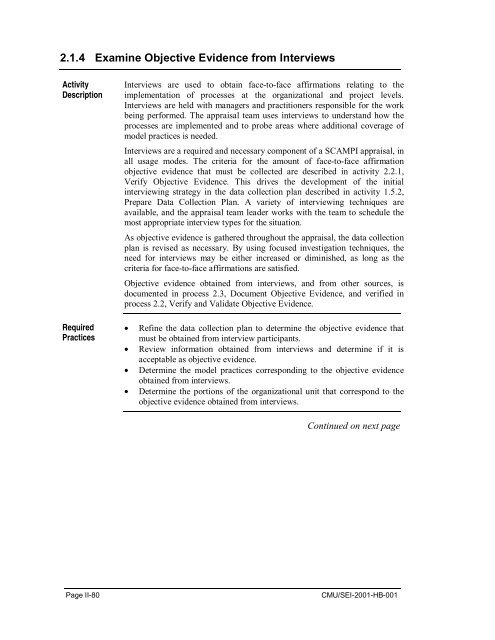Standard CMMI Appraisal Method for Process Improvement (SCAMPI)
Standard CMMI Appraisal Method for Process Improvement (SCAMPI)
Standard CMMI Appraisal Method for Process Improvement (SCAMPI)
You also want an ePaper? Increase the reach of your titles
YUMPU automatically turns print PDFs into web optimized ePapers that Google loves.
2.1.4 Examine Objective Evidence from Interviews<br />
Activity<br />
Description<br />
Required<br />
Practices<br />
Interviews are used to obtain face-to-face affirmations relating to the<br />
implementation of processes at the organizational and project levels.<br />
Interviews are held with managers and practitioners responsible <strong>for</strong> the work<br />
being per<strong>for</strong>med. The appraisal team uses interviews to understand how the<br />
processes are implemented and to probe areas where additional coverage of<br />
model practices is needed.<br />
Interviews are a required and necessary component of a <strong>SCAMPI</strong> appraisal, in<br />
all usage modes. The criteria <strong>for</strong> the amount of face-to-face affirmation<br />
objective evidence that must be collected are described in activity 2.2.1,<br />
Verify Objective Evidence. This drives the development of the initial<br />
interviewing strategy in the data collection plan described in activity 1.5.2,<br />
Prepare Data Collection Plan. A variety of interviewing techniques are<br />
available, and the appraisal team leader works with the team to schedule the<br />
most appropriate interview types <strong>for</strong> the situation.<br />
As objective evidence is gathered throughout the appraisal, the data collection<br />
plan is revised as necessary. By using focused investigation techniques, the<br />
need <strong>for</strong> interviews may be either increased or diminished, as long as the<br />
criteria <strong>for</strong> face-to-face affirmations are satisfied.<br />
Objective evidence obtained from interviews, and from other sources, is<br />
documented in process 2.3, Document Objective Evidence, and verified in<br />
process 2.2, Verify and Validate Objective Evidence.<br />
• Refine the data collection plan to determine the objective evidence that<br />
must be obtained from interview participants.<br />
• Review in<strong>for</strong>mation obtained from interviews and determine if it is<br />
acceptable as objective evidence.<br />
• Determine the model practices corresponding to the objective evidence<br />
obtained from interviews.<br />
• Determine the portions of the organizational unit that correspond to the<br />
objective evidence obtained from interviews.<br />
Continued on next page<br />
Page II-80<br />
CMU/SEI-2001-HB-001
















